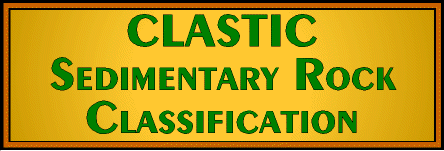
|
CLASSIFICATION SYSTEMS:
>> QFL Key >> QFL Ternary IDENTIFICATION KEYS:
|
INTRODUCTION TO QFL
QFL stands for Quartz, Feldspar, Lithics
Sedimentary rocks are classified on the basis of the texture (grain size) of the rock, and composition.
The basic classification only concerned texture, using the Wentworth size scale. But any full rock name must specify both texture and composition. Thus, an arkose sandstone is a rock of sand sized particles, with a high percentage of those particles being feldspar.
It might seem that an unlimited variety of particles could end up in a sedimentary rock. After all, there are over 6000 known minerals. In addition, any incompletely weathered piece of igneous, sedimentary, or metamorphic rock can also be found in a sedimentary rock.
A composition classification could become very complicated if all of these different particles were considered. But in most cases rock composition can be defined by four compositional components:
>>> Quartz
>>> Feldspar
>>> Lithic fragments (including rock fragments and mineral grains other than quartz)
>>> Matrix (a catchall for the silt and clay grains that cannot be easily seen by eye).
Descriptions of each category are below. You will learn to recognize and identify them as you study the rocks.
| COMPONENTS OF SILICICLASTIC SEDIMENTARY ROCK COMPOSITION | |
| Quartz | Since quartz, for all practical purposes, does not weather into anything else, and will remain after everything else is weathered or sorted out, it is one of the most important of the four components of sedimentary rock composition. Pure quartz sandstones are rare. Usually quartz is mixed with one or more of the remaining three components. Pure quartz sandstones form only under great tectonic stability when the land is not high enough for rocks to be exposed to weathering, such as during Wilson Cycle Stage A and Stage I. |
| Feldspar | Feldspars are some of the most abundant minerals in the earth's crust. With only a few exceptions all igneous rocks have large amounts of feldspar; e.g. calcium plagioclase in gabbro, and sodium plagioclase and orthoclase in granite. Medium to high grade metamorphic rocks also have large amounts of feldspar. Sediments near high mountains frequently have large percentages of feldspar as batholiths and regional metamorphic rocks are uplifted and eroded (Wilson Cycle Stage F and Stage H). Rift systems (Stage B and Stage C) frequently also have large amounts of feldspar. |
| Lithics | Very simply, if a siliciclastic particle is not quartz or feldspar it is classified a lithic fragment. Lithic means "rock" and all mechanically weathered pieces of another rock, or non-feldspar minerals weathered from a rock, are included here. Frequently they are small, dark in color, and difficult or impossible to specifically identify in hand specimen. The exception to this is conglomerates and breccias. Lithic fragments are especially abundant in volcanic arc systems (Stage E), but are common in most collision mountain buildings (Stage F and Stage H). |
| Matrix | Matrix is the finer material in which larger particles are embedded. So, in a sandstone the matrix is silt and clay. In a gravel the matrix may be a sand. However, since all minerals other than quartz will eventually weather into silt or clay sized particles, silt or clay is very common in sedimentary rocks. |
QFL CLASSIFICATION
AND IDENTIFICATION SYSTEMS
AND IDENTIFICATION SYSTEMS
A Key For Clastic Sedimentary Rock Identificaton
The simplest way to identify clastic rocks from composition and texture is with a key. To use the key you might need several things:>>> A handlens to identify feldspar and lithics, especially with sand sized grains.
>>> A metric ruler or grain size chart (link).
>>> Some experience in identifying minerals and rock fragments in a rock.
Identifying QFL in a rock usually takes practice. One way to proceed is to have hand samples of quartz and the feldspars to compare with. A second option is to go to (or print out in color) Bowen's Reaction Series where the minerals are listed, with large scale pictures available for comparison.
Recognizing quartz often gives new people trouble; they often want to identify it as feldspar. The problem is quartz can be clear and glassy, or rounded and frosted. It also varies in color from gray, to white, to pink, etc. But, with rare exceptions, most of the minerals in a rock will be quartz since it is the most abundant sand sized particle, and as weathering takes place it just keep increasing in abundance.
Feldspars, on the other hand, have cleavage faces (quartz has no cleavage) that can sometimes be seen with careful looking, such as in Ca plagioclase, Na plagioclase, and orthoclase.
The key is going to drop the rocks into relatively clear-cut categories of arkosic, lithic, and quartz rich, and further subdivide them on grain size.
|
|
A Ternary System
For Clastic Sedimentary Rock Identificaton
The classification key used above seems very straight forward - until one begins to look at actual rocks. Then we begin to see that not all rocks are pure sandstone, or shale, but are often mixtures of grain sizes. Likewise, rocks are often not pure arkoses (feldspar rich) but may also have mixtures of lithics too.For Clastic Sedimentary Rock Identificaton
Thus, we need a classification system that not only can handle the pure rocks, but also all the combinations in between. And it should be easy to use.
The universal system used by geologists is based on the ternary diagram. Ternary diagrams are not hard to read, but if you are not familiar with them read the short primer to ternary diagrams.
This classification requires two ternary diagrams, one for determining texture, a second for determining QFL. These diagrams are discussed separately below, but are also combined into one diagram. And sometimes we need a chart to help estimate percent abundance
QFL Diagram:
 The QFL diagram is to the right. Observe the following:
The QFL diagram is to the right. Observe the following:>>>> Quartz is at the top, feldspar on the lower left, and lithics on the lower right. It is always done this way.
>>>> The ternary diagram is divided into 5 fields, here color coded. The boundaries among the fields, left and right, are at the 50% boundary, and up and down at the 75% and 90% boundaries.
>>>> As you travel toward any apex the quantity of Q, F, or L increases accordingly, with 100% being, of course, right at the apex.
>>>> Notice that as we travel vertically the amount of quartz in the rock increases, and at the 90% boundary and above the rock has so much quartz the rock becomes a "quartz something", such as a quartz sandstone or quartz conglomerate.
>>>> The lower two fields contain rocks that are felspar (red) or lithic (blue) rich. That is, these rocks have more than 25% feldspar or lithics, that is, 25-100% feldspar or lithics.
Rocks with this composition have such names as feldspathic (arkosic) sandstone (both terms are used interchangably) and lithic sandstone.
>>>> Remember that all feldspar and lithic fragments are going to weather and disappear (to shale or dissolved minerals), leaving only quartz. On the QFL diagram, however, we can only plot the abundance of sand (or larger) particles of various compositions. So, on this diagram, as feldspar and lithics weather the composition of the remaining sandstone migrates toward the quartz apex. No matter where you start on the diagram the sediment is going to evolve in almost a straight line right to the top.
One of the things we are very interested in is how close the sediment has gotten along its path of evolution. This is the concept of sediment maturity. Thus, above the arkosic and lithic fields, but below the quartz field are two more fields, subarkosic and sublithic. Rocks in these fields have between 10-25 % feldspar or lithics and are thus farther along in their evolution toward pure quartz than feldspathic or lithic rocks.
>>>> In other classsification systems, the boundaries among the fields sometimes differ from this one, and there may be more fields than 5 laid out. It all depends on what the geologist wants to do with them. But for this site we will always have these five fields, in these five places.
 >>>> Observe that a composition plotted somewhere in the middle of the QFL indicates a mixed composition. For example, the composition of "A" to the right is about 50% quartz, 35% feldspar, and 25% lithics (ternary with percent numbers). We could just call it an arkose since it falls in the feldspar field, but it would be more accurate to indicate that a lot of lithics are present too. Such a name, following the rules for naming rocks, is lithic, feldspathic, quartz.
>>>> Observe that a composition plotted somewhere in the middle of the QFL indicates a mixed composition. For example, the composition of "A" to the right is about 50% quartz, 35% feldspar, and 25% lithics (ternary with percent numbers). We could just call it an arkose since it falls in the feldspar field, but it would be more accurate to indicate that a lot of lithics are present too. Such a name, following the rules for naming rocks, is lithic, feldspathic, quartz.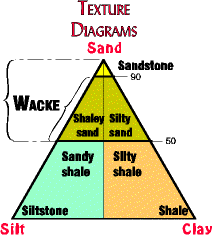
Texture Diagrams:
The basic texture diagram is to the right. Observe the following:>>>> This diagram is also divided into five fields, but the percentage cutoffs differ from the QFL diagram.
>>>> The apexes are sand, silt, and clay. Where QFL apexes remain constant, texture apexes commonly change for different uses. Always check the apexes. Later we will use some different apexes to explore some ideas.
>>>> WACKE :-). Sandstone, siltstone, and shale are easy to identify. And even a sandy shale or sandy siltstone is not bad.
But the shaley sand and silty sand fields, in practice, are difficult or impossible to distinguish from each other, even under a good microscope. To save ourselves a lot of grief we lump these together under the name "wacke".
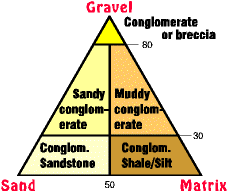 >>>> If a rock has gravel sized particles then we need a ternary diagram with gravel at one apex, as to the right. The fields have also changed boundary conditions.
>>>> If a rock has gravel sized particles then we need a ternary diagram with gravel at one apex, as to the right. The fields have also changed boundary conditions.Observe here that sand has moved to another apex, and that silt and clay have been combined into one category, matrix.
To name a clastic sedimentary rock we must plot the composition on the QFL diagram, and the texture on the texture diagram, and then combine the two to get the full name. See example below. for a specimen plotted at "A"
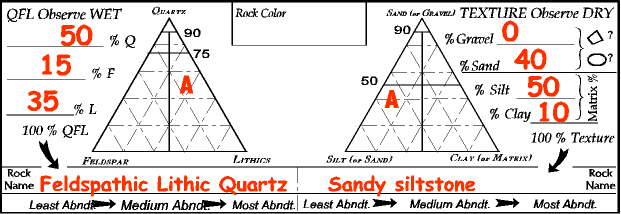
>>>> A couple of simplifying rules (after all names can get quite complex!). If quartz is the most abundant composition it can usually be left out of the name; it is implied then that quartz is present and most abundant. However, if it is not the most abundant it must be included in order of its abundance.
And, when a composition is less than 10% we often leave it out too.
>>>> AND a practical consideration. How do you learn how to estimate percentage abundances? The most common method is to use a percent abundance chart.
So, What is All This Good For?
Now, one might be inclined to say that this is sure a lot of trouble just to name a rock! Well, yes. But for a beginner what it teaches are observation skills.What it also teaches is how to read the ternary diagrams intuitively because when we talk about the evolution of sedimentary rocks it is not the specific rock names we are interested in, it is the way the composition of the sandstone moves across the diagram as weathering and transportation occurs.
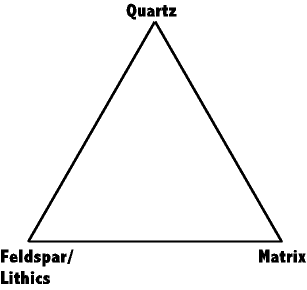 For example, look at apexes of the ternary diagram to the right. Note quartz is at the top, but feldspar and lithics are combined in the lower left; this is because both of these weather into something else - matrix. So, matrix is in the lower right.
For example, look at apexes of the ternary diagram to the right. Note quartz is at the top, but feldspar and lithics are combined in the lower left; this is because both of these weather into something else - matrix. So, matrix is in the lower right.Question: >>>>> Now, assume a granite has 25% quartz and the rest feldspar and lithics (mafic minerals). Where would you plot it on the diagram?
Question 2: >>>>> Now assume the granite is going to weather, but not be transported or sorted. How would the composition change on the diagram?
Question 3: >>>>> Now transport and sort the sediment. What paths would the components take on the diagram?
Answers Here:
The point is, everything we have learned about sedimentary rocks over the past pages and pages of text and diagrams can all be summarized in this one simple diagram - if you understand and know how to read it. Such diagrams are quick, easy, and slick, and tell a geologist at a glance a world of information - without getting mired in all the technical details.